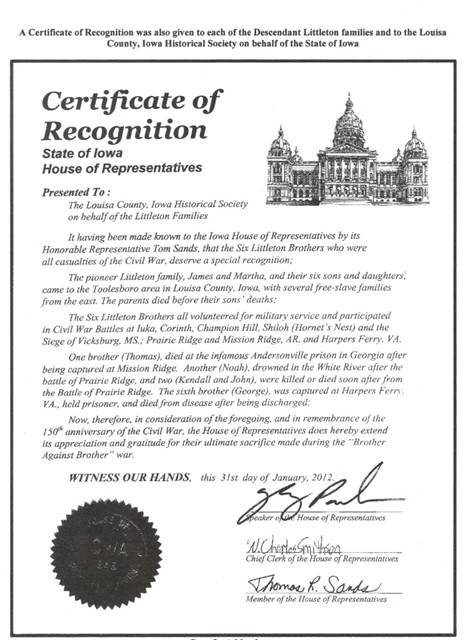Littleton Advisory Committee
Chairman - Tom Woodruff email apwood70@aol.com
Treasurer – Ed Bayne email edsot@louisacomm.net
Frank Best, Pres. LCHS ~ Sandi Kiene ~ Mallory Smith ~ Mary L. Bayne ~ Verl Lekwa ~ Julie Wagner ~ Andrew Beaver ~ Mary Masonholder ~ Kathy Vance ~ Benita Grooms ~ Larry Roehl ~ Doris Woodruff
The Civil War was the bloodiest war in American history. It cost the lives of about 620,000 soldiers; over 200,000 of them in combat operations. One Louisa County family – the Littleton family – lost six sons in that horrible war – sons who volunteered to fight for their country. This is a story that must never be forgotten. It is a goal of the Louisa County Historical Society, with the help of others, to establish a memorial in honor of the Littleton brothers and their family.
The discovery of this historic tale began in 2010 when Rosalee Swanson Thomas of Raleigh, N.C., offered Tom Woodruff of Louisa County, Iowa, her grandmother’s 57 page news clipping scrap book. He grandmother, Olive Mary Kemp Carey, had diligently documented news from the late 1800’s into the 1900’s in her Southeast Iowa home in Louisa County. Rosalee Thomas wanted Tom Woodruff, her deceased husband’s boyhood friend and long time member of the Louisa County Historical Society, to have this collection in case it would be of interest to their local historians.
Upon receipt of this scrap book, Tom began to curate the historical news that was thoughtfully assembled. On page 23, he found something that would change his life forever, rippling though the lives of everyone associated with the LCHS, and beyond.
Buried in a “Local History” column from the May 2, 1907, edition of the Columbus Gazette was a section talking about those who served in the American Civil War from Jefferson Township in Louisa County:
The Lyttleton (sic) family were less fortunate. Of the six brothers, only one lived to return and he shortly died of disease contracted in the service.
Six brothers from a family of 10 children, all perished because of the Civil War.
The hunt for information was on. Ed Bayne joined Tom Woodruff in leading the LCHS team in its quest to learn as much as they could about this epic historical event. The LCHS quickly invested themselves into gathering as much information as possible so that they could share this legacy with others.
Through research it was revealed that James Littleton married Martha (maiden name unknown) and started a family. The Littleton’s left Maryland, in probably late 1836, with their first three children; George H. (b. 1828), John W. (b. 1831) and Thomas S. (b. 1836), Perhaps it was the pending birth of their fourth child that caused them to halt their westward journey, living in Ohio, long enough to expand their family by two more children – William M. (b. 1837) and Mary (b. 1839).
The family arrived in Louisa County in 1840, where the Iowa Territory had beckoned them and many other pioneers with the promise of inexpensive, fertile land near the Mississippi River.
James Littleton acquired 200 acres of land located in Jefferson Township. His family continued to expand, with Rebecca (b. 1841), Permilla (b. 1843), Kendall (b. 1843), Noah (b. 1845) and Sarah (birth date not yet known).
In the 1860 Federal Census of Louisa County, James Littleton and his sons Kendall, William, and Noah were listed as Mullatos; men with mixed blood.
The mother, Martha Littleton died on April 17, 1853. Her husband James died on November 19, 1860. Their graves are located in Potters Timber Cemetery about six miles east of Wapello, on land once owned by James.
In our country, war clouds were brewing over the horizon.
From the time the US Government was established up to 1860, slavery, as a public question, entered into nearly every political contest.
With the rapid growth of the North, and the formation of the new States without slavery, this alarmed the Southern people, who feared the loss of power and their States’ rights.
The “Missouri Compromise", had terms that confined slavery south of an imaginary line known as the Mason and Dixon line. When it was repealed and the Kansas-Nebraska Bill was adopted, it opened the question of bringing slaves into the Territories.
The Republican party, was formed for the purpose of preventing any further extension of slavery. This was regarded as a menace by the South and threats of secession were made in the event of that party coming into power.
In the Presidential campaign of 1860, the election of Republican, Abraham Lincoln was almost a foregone conclusion. While it was known that there were many hot-headed men in the South willing to plunge the country into civil war, few persons believed that the threats would be carried out.
Little was known of the preparations being made in the South. South Carolina and other States passed ordinances of secession, and preparations were made to resist any force that would be sent against them, as well as to obtain possession of any property belonging to the General Government within the limits of their States.
At Charleston, S. C., two forts were in the possession of the United States authorities, Forts Moultrie and Sumter. Only Fort Sumter was in use under the command of Major Anderson and a small band of loyal men. Early in April 1861, the authorities of South Carolina demanded their surrender, and it was refused.
On the morning of April 12th, the rebels opened fire. The brave men within the fort fought back hard, but on the 14th they were compelled to lower their flag and yield to the rebels.
The gun fire upon Fort Sumter reverberated throughout the land. On April 15th the War Between the States officially began. The President issued his call for 75,000 ninety-days troops.
The State of Iowa was required to form 10 companies. The point of rendezvous was Camp McClellan near Davenport, IA. Two days afterward Governor Samuel Kirkwood issued his proclamation for the men of Iowa to offer their services to the Union. Volunteers came from all vocations in life.
Within thirty days after the President's demand was made public, Iowa had a regiment in the field.
The State of Iowa sent more men, and lost more men, proportionately than any other state in the United States, north or south. According to the Civil War Statistician’s Frederick H. Dyer’s “A compendium of the War of the Rebellion” (1908) showed “3,540 killed and mortally wounded; 8,498 died of disease; 515 died as prisoners of war; 227 deaths from accident, et; and 221 (other) deaths, all causes except in battle; total deaths, 13,001 (this number may actually be more that 15,000).”
There is no doubt that any loss of life in war is terrible, yet the loss of all six brothers from one family serves as the grime reminder of all possible sacrifices exacted by a war that still reverberates in our national conscience.
When the Littleton brothers enlisted in the Union army, five of them were residents of Toolesboro, Iowa. One, George the oldest, lived across the Mississippi River in New Boston, Illinois.
The following are the military records of the six brothers in order by enlistment date.
THOMAS S. LITTLETON, age 25, was the first Littleton brother to enlist in the Union Army on July 1, 1861. On July 16, 1861 he mustered into Company C of the 5th Iowa Infantry Regiment.
During the attack against troops led by Confederate General Sterling Price at Iuka, Mississippi on September 19, 1862 Thomas received a head wound of which he recovered from.
He participated in the battle of Corinth, Mississippi on October 2 and 3, 1862 and came away unscathed. In 1863 he fought in a bloody battle at Champions Hill, Mississippi. In that same year he also fought in the Battle of the Siege of Vicksburg, Mississippi. In early November, 1863 his regiment crossed the Tennessee River and during the battle of Missionary Ridge on November 25, 1863, he was captured by the Confederates and sent by rail to the infamous Andersonville prison in Georgia. He died while a prisoner there and is buried in Andersonville National Cemetery in grave number 2045.
WILLIAM LITTLETON was 24 years old when he enlisted on September 21, 1861. He was mustered out on September 21, 1861 with Company K, 8th Iowa Volunteer Infantry Regiment.
At the Battle of Shiloh on April 6, 1862, he was assigned to serve under General Prentiss. The entire army led by Prentiss was surrounded in what later became known as the “Hornets’ Nest”. Nearly every man was killed or captured and sent to Confederate prisons at that location.
William was wounded during the battle and had been evacuated to a field hospital before his regiment was surrounded and thus escaped capture.
The following year, in 1863, he participated in the Battle of Jackson, Mississippi and also in the Siege and surrender of Vicksburg. In November 1863 while continuing with other skirmishes, he contracted chronic diarrhea and was sent by hospital ship to Benton Barracks in St. Louis, Missouri. He died of his disease on December 8, 1863 and is buried in Jefferson Barracks National Cemetery in section 31, grave number 101.
GEORGE LITTLETON enlisted on March 26, 1862 at age 33 and was the oldest of the six Littleton brothers. He was living in New Boston, Illinois, just across the Mississippi River from Toolesboro, Iowa, when he enlisted.
He was assigned to Company B, Illinois 65th Infantry Regiment. The 65th Infantry was known as the “Scotch” Regiment”. The 65th Regiment was ordered to Martinsburg, Virginia and brigaded there with a regiment from New York.
The 65th fought in the Battle of Harpers Ferry, Virginia, where the entire regiment was captured and sent to a Confederate prison. They were later paroled and sent to Chicago, where he was discharged with disease on October 31, 1862.. The Louisa County, Iowa Columbus Gazette reported in an old history column that George returned home and died soon after.
His date of death and place of burial is not known. It is thought that he could be buried in Potter’s Timber Cemetery, near his parents, in an unmarked grave.
JOHN, age 31, KENDALL, age 19, and NOAH LITTLETON, age 18, enlisted together on August 21, 1862. They were mustered into Company F, 19th Iowa Voluntary Infantry Regiment.
The three brothers were soon to fight together on December 7th, 1862 in the Battle of Prairie Grove, Arkansas located along the Illinois River area.
KENDALL was killed in the Battle of Prairie Grove that day on December 7th, 1862 and buried there in a mass grave on the battlefield.
JOHN was severely wounded in the battle. He was sent to a field hospital in Fayetteville, Arkansas, where he died from those wounds eleven days later on December 18, 1863. He was buried there in an unmarked grave with many others.
NOAH, age 18, escaped unharmed from the Battle of Prairie Grove. He was one of seven men of the 19th Regiment who drowned when the ferry boat they were on sank in the White River at Forsyth, Missouri, on March l, 1863. He was buried in the National Cemetery in Springfield, Missouri at site number 16, grave number 893.
The Littleton brothers put their lives on the line to fight alongside their friends and neighbors in a war that was fought by the northern states to hold the Union together and end the practice of slavery.


